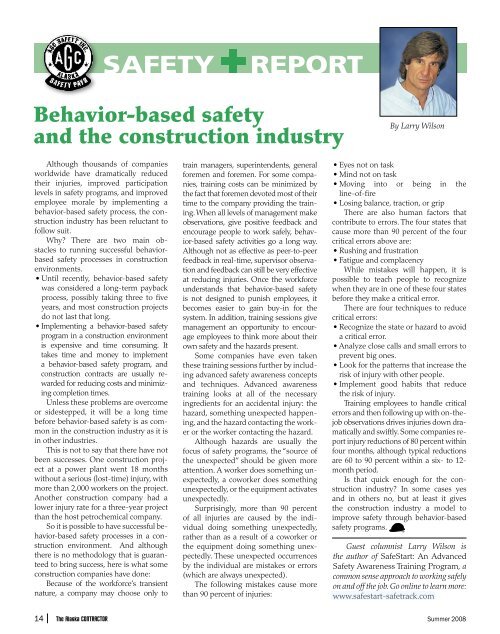The Alaska Contractor - Summer 2008
The Alaska Contractor - Summer 2008
The Alaska Contractor - Summer 2008
Create successful ePaper yourself
Turn your PDF publications into a flip-book with our unique Google optimized e-Paper software.
Behavior-based safety<br />
and the construction industry<br />
Although thousands of companies<br />
worldwide have dramatically reduced<br />
their injuries, improved participation<br />
levels in safety programs, and improved<br />
employee morale by implementing a<br />
behavior-based safety process, the construction<br />
industry has been reluctant to<br />
follow suit.<br />
Why? <strong>The</strong>re are two main obstacles<br />
to running successful behaviorbased<br />
safety processes in construction<br />
environments.<br />
• Until recently, behavior-based safety<br />
was considered a long-term payback<br />
process, possibly taking three to five<br />
years, and most construction projects<br />
do not last that long.<br />
• Implementing a behavior-based safety<br />
program in a construction environment<br />
is expensive and time consuming. It<br />
takes time and money to implement<br />
a behavior-based safety program, and<br />
construction contracts are usually rewarded<br />
for reducing costs and minimizing<br />
completion times.<br />
Unless these problems are overcome<br />
or sidestepped, it will be a long time<br />
before behavior-based safety is as common<br />
in the construction industry as it is<br />
in other industries.<br />
This is not to say that there have not<br />
been successes. One construction project<br />
at a power plant went 18 months<br />
without a serious (lost-time) injury, with<br />
more than 2,000 workers on the project.<br />
Another construction company had a<br />
lower injury rate for a three-year project<br />
than the host petrochemical company.<br />
So it is possible to have successful behavior-based<br />
safety processes in a construction<br />
environment. And although<br />
there is no methodology that is guaranteed<br />
to bring success, here is what some<br />
construction companies have done:<br />
Because of the workforce’s transient<br />
nature, a company may choose only to<br />
SAFETY REPORT<br />
train managers, superintendents, general<br />
foremen and foremen. For some companies,<br />
training costs can be minimized by<br />
the fact that foremen devoted most of their<br />
time to the company providing the training.<br />
When all levels of management make<br />
observations, give positive feedback and<br />
encourage people to work safely, behavior-based<br />
safety activities go a long way.<br />
Although not as effective as peer-to-peer<br />
feedback in real-time, supervisor observation<br />
and feedback can still be very effective<br />
at reducing injuries. Once the workforce<br />
understands that behavior-based safety<br />
is not designed to punish employees, it<br />
becomes easier to gain buy-in for the<br />
system. In addition, training sessions give<br />
management an opportunity to encourage<br />
employees to think more about their<br />
own safety and the hazards present.<br />
Some companies have even taken<br />
these training sessions further by including<br />
advanced safety awareness concepts<br />
and techniques. Advanced awareness<br />
training looks at all of the necessary<br />
ingredients for an accidental injury: the<br />
hazard, something unexpected happening,<br />
and the hazard contacting the worker<br />
or the worker contacting the hazard.<br />
Although hazards are usually the<br />
focus of safety programs, the “source of<br />
the unexpected” should be given more<br />
attention. A worker does something unexpectedly,<br />
a coworker does something<br />
unexpectedly, or the equipment activates<br />
unexpectedly.<br />
Surprisingly, more than 90 percent<br />
of all injuries are caused by the individual<br />
doing something unexpectedly,<br />
rather than as a result of a coworker or<br />
the equipment doing something unexpectedly.<br />
<strong>The</strong>se unexpected occurrences<br />
by the individual are mistakes or errors<br />
(which are always unexpected).<br />
<strong>The</strong> following mistakes cause more<br />
than 90 percent of injuries:<br />
By Larry Wilson<br />
• Eyes not on task<br />
• Mind not on task<br />
• Moving into or being in the<br />
line-of-fire<br />
• Losing balance, traction, or grip<br />
<strong>The</strong>re are also human factors that<br />
contribute to errors. <strong>The</strong> four states that<br />
cause more than 90 percent of the four<br />
critical errors above are:<br />
• Rushing and frustration<br />
• Fatigue and complacency<br />
While mistakes will happen, it is<br />
possible to teach people to recognize<br />
when they are in one of these four states<br />
before they make a critical error.<br />
<strong>The</strong>re are four techniques to reduce<br />
critical errors:<br />
• Recognize the state or hazard to avoid<br />
a critical error.<br />
• Analyze close calls and small errors to<br />
prevent big ones.<br />
• Look for the patterns that increase the<br />
risk of injury with other people.<br />
• Implement good habits that reduce<br />
the risk of injury.<br />
Training employees to handle critical<br />
errors and then following up with on-thejob<br />
observations drives injuries down dramatically<br />
and swiftly. Some companies report<br />
injury reductions of 80 percent within<br />
four months, although typical reductions<br />
are 60 to 90 percent within a six- to 12month<br />
period.<br />
Is that quick enough for the construction<br />
industry? In some cases yes<br />
and in others no, but at least it gives<br />
the construction industry a model to<br />
improve safety through behavior-based<br />
safety programs.<br />
Guest columnist Larry Wilson is<br />
the author of SafeStart: An Advanced<br />
Safety Awareness Training Program, a<br />
common sense approach to working safely<br />
on and off the job. Go online to learn more:<br />
www.safestart-safetrack.com
















